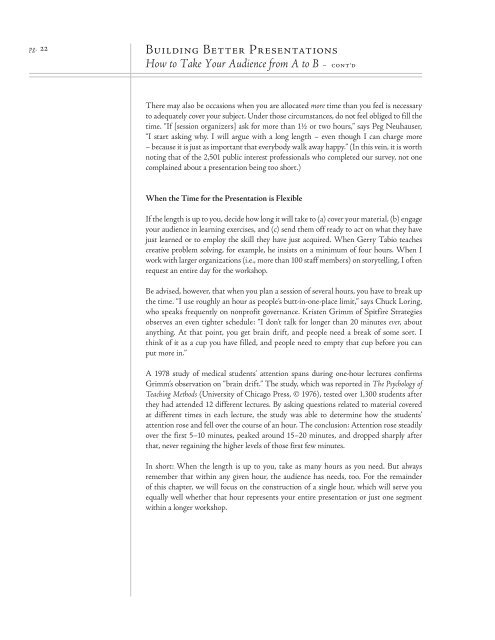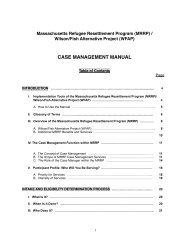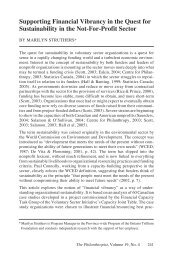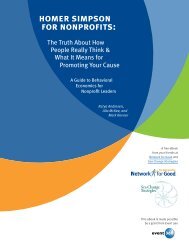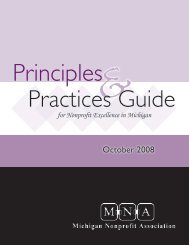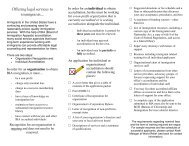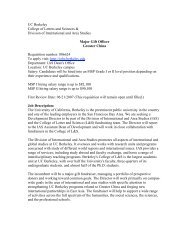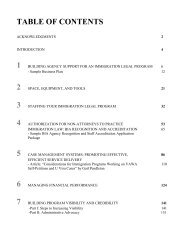Why Bad Presentations Happen to Good Causes - The Goodman ...
Why Bad Presentations Happen to Good Causes - The Goodman ...
Why Bad Presentations Happen to Good Causes - The Goodman ...
You also want an ePaper? Increase the reach of your titles
YUMPU automatically turns print PDFs into web optimized ePapers that Google loves.
pg. 22<br />
Building Better <strong>Presentations</strong><br />
How <strong>to</strong> Take Your Audience from A <strong>to</strong> B – cont’d<br />
<strong>The</strong>re may also be occasions when you are allocated more time than you feel is necessary<br />
<strong>to</strong> adequately cover your subject. Under those circumstances, do not feel obliged <strong>to</strong> fill the<br />
time. “If [session organizers] ask for more than 1½ or two hours,” says Peg Neuhauser,<br />
“I start asking why. I will argue with a long length – even though I can charge more<br />
– because it is just as important that everybody walk away happy.” (In this vein, it is worth<br />
noting that of the 2,501 public interest professionals who completed our survey, not one<br />
complained about a presentation being <strong>to</strong>o short.)<br />
When the Time for the Presentation is Flexible<br />
If the length is up <strong>to</strong> you, decide how long it will take <strong>to</strong> (a) cover your material, (b) engage<br />
your audience in learning exercises, and (c) send them off ready <strong>to</strong> act on what they have<br />
just learned or <strong>to</strong> employ the skill they have just acquired. When Gerry Tabio teaches<br />
creative problem solving, for example, he insists on a minimum of four hours. When I<br />
work with larger organizations (i.e., more than 100 staff members) on s<strong>to</strong>rytelling, I often<br />
request an entire day for the workshop.<br />
Be advised, however, that when you plan a session of several hours, you have <strong>to</strong> break up<br />
the time. “I use roughly an hour as people’s butt-in-one-place limit,” says Chuck Loring,<br />
who speaks frequently on nonprofit governance. Kristen Grimm of Spitfire Strategies<br />
observes an even tighter schedule: “I don’t talk for longer than 20 minutes ever, about<br />
anything. At that point, you get brain drift, and people need a break of some sort. I<br />
think of it as a cup you have filled, and people need <strong>to</strong> empty that cup before you can<br />
put more in.”<br />
A 1978 study of medical students’ attention spans during one-hour lectures confirms<br />
Grimm’s observation on “brain drift.” <strong>The</strong> study, which was reported in <strong>The</strong> Psychology of<br />
Teaching Methods (University of Chicago Press, © 1976), tested over 1,300 students after<br />
they had attended 12 different lectures. By asking questions related <strong>to</strong> material covered<br />
at different times in each lecture, the study was able <strong>to</strong> determine how the students’<br />
attention rose and fell over the course of an hour. <strong>The</strong> conclusion: Attention rose steadily<br />
over the first 5–10 minutes, peaked around 15–20 minutes, and dropped sharply after<br />
that, never regaining the higher levels of those first few minutes.<br />
In short: When the length is up <strong>to</strong> you, take as many hours as you need. But always<br />
remember that within any given hour, the audience has needs, <strong>to</strong>o. For the remainder<br />
of this chapter, we will focus on the construction of a single hour, which will serve you<br />
equally well whether that hour represents your entire presentation or just one segment<br />
within a longer workshop.


